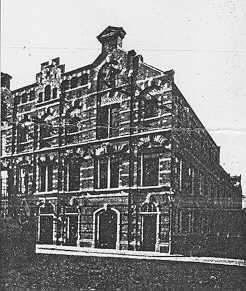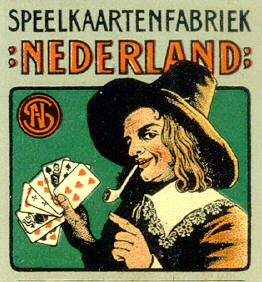
Here in "THE STUDY" you'll find..... |
-1-
Holland was a prosperous country in the 17th century. Here those days are still known as "The Golden Century". A few great Dutch cardmakers were then known throughout Europe: Pieter Meffert and later Jonas Fouquet. In the 19th century the decline slowly began. The number of small playing card manufacturers decreased until around 1860, when there are (as far as we know) none left.
Playing cards were imported from Germany and Belgium. Firms like Dondorf and Wüst exported their high quality cards for the Dutch market, the Belgian firms from Turnhout supplied the lesser quality decks.
.....the
original building of the NSF in Utrecht.....
On November 1st, 1906 two Dutch publishers, A.E. van der Heide from Haarlem and W. van Leijdenroth from Utrecht, and a related printer, the Widow A.J. Leijdenroth van Broekhoven, founded a new firm: "De Nederlandsche Speelkaartenfabriek". It was situated in Utrecht. In 1908 mr. Van der Heide retired and in 1909 a new partner was found in Amsterdam: the lithographer Jos. Vas Dias & Co. who probably had a greater experience with (chromo)lithography. On March 16th 1909 a new company was founded: "N.V. Nederlandsche Speelkaartenfabriek en Steendrukkerij". In August the company moved to Amsterdam, where the factory of a liquidated firm, situated on Prinseneiland 153-155, provided more productionspace. It takes about a year before their products are first offered in a journal for booksellers. The delay is caused by the new machinery, that had to be ordered and placed, the necessary (re)buildingpermits, that had to be obtained, and the hiring of new personel.
On February 8th, 1911 production is delayed again. A fire destroys the attick and the waterdamage is great.
the factory at Prinseneiland
153-155......
Maybe because of all these delays and the extra costs, maybe because of competition from other countries: a petition in bankruptcy was filed and adjudged in May 1912. One of the curators is a director of the "N.V. P.C.J. Faddegon & Co.", a firm that exploits a lithographic and book printing office, besides a cardboard factory. This firm is located on the Haarlemmer Houttuinen, quite near to the factory on Prinseneiland. As Faddegon has great experience in lithography and cardboard making, a take-over of the "NV Nederlandsche Speelkaartenfabriek" is a logical step. The factories are located close to eachother, so an efficient company management was possible and the production of playing cards formed a good extension to the line of the Faddegon products.


In August 1912 the clients were informed of the take-over and the new name of the company: officially the "Speelkaartenfabriek "Nederland" van de NV Steen- en Boekdrukkerij & Cartonnagefabriek v/h Faddegon & Co."
 "
"
After the bankruptcy was adjudged in May 1912, the inventory of the factory was auctioned on July 18th and 19th. Faddegon bought everything that was used for the production of playing cards, like 242 lithographic stones and a steam-frictionmachine. Besides that they acquired ca. 10.000 sheets of playingcard cardboard , but probably their best buy was 300 kilogram of playing cards for less than 10 dutch guilders (ca $ 5.00).
The production of playing cards remained in the factory on Prinseneiland 153-155, although this factory was partly dismantled. In 1914 the production was moved to the factory on Haarlemmer Houttuinen 29-35A, where all the printing activities were brought together. The cardboard factory was moved to Prinseneiland 153-155.
 .....control slips.....
.....control slips.....
In World War I the Netherlands remained impartial . Business was good in those years for the company: their competitors in Germany had to cut back on their export and in Belgium production nearly game to a halt. Thus it was easy to win the Dutch market back. The company invested their profits in new storage and production facilities. At the end of 1918 the company of Faddegon had 6 rapid lithography presses,10 hand presses and a big drying machine that could handle 6000 sheets of playing cards per day.

Ca. 11.000 small lithographic stones were kept as model and stored. The bigger stones were polished and re-used. Different disciplines of the company were active in the process of making playing Cards. The playing card factory (SN) was not completely self supporting. The type-setting was done by the bookprint shop, printing was done by the print shop, the cutting was done in the bookbinding shop. Production costs were accounted for within the company of Faddegon. The playing cards factory processed the printed sheets. They frictioned the sheets with chemicals, up to twenty times for the luxury decks, in order to get a good quality, glossy, card. Afterwards the sheets went to the drying machine, that took up most of the space in the playing card department. Daily 6000 sheets passed the drying machine. Afterwards the sheets are cut, the cards are sorted and finally packed. The carton boxes, wrappers etc. were supplied by the cardboard shop of Faddegon on the Prinseneiland.